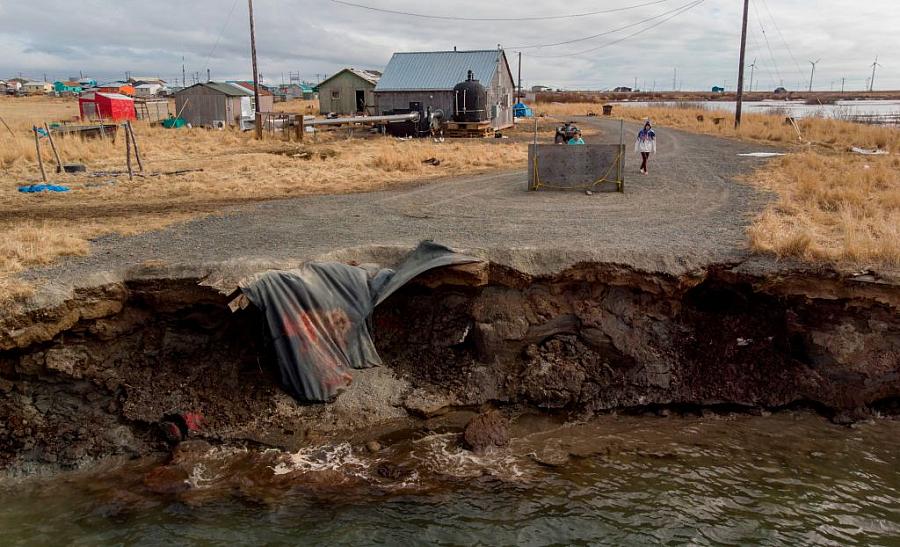The pandemic casts a new light on enduring public health threats in Alaska

Erosion caused by melting permafrost tundra and the disappearance of sea ice threatens houses from the Yupik Eskimo village of Quinhagak on the Yukon Delta in Alaska.
(Mark Ralston/AFP via Getty Images)
In rural Alaska, where the population is largely Indigenous, inadequate water and sanitation services and overcrowded housing conditions have exacerbated the spread of COVID-19.
This particular disease may be new, but the connection between respiratory diseases and inadequate water and wastewater service and housing is not.
It’s long been a concern in Alaska. It’s been a serious concern across the non-Scandinavian Arctic. And it was a major focus of the U.S. chairmanship of the Arctic Council, for example.
My fellowship project for the 2021 National Fellowship will examine how COVID-19 has highlighted these infrastructure shortcomings connected to health – and, more importantly, the options for finding solutions. These problems exist beyond Alaska and the Arctic, so responses and solutions in Alaska could serve as examples that benefit people elsewhere.
My project will require some travel within Alaska. Getting out to regional hubs is likely pretty easy (albeit expensive), but travel to outlying villages will likely be more difficult (and more expensive). Some villages still have travel restrictions in place, as residents are wary of outsiders coming in and spreading germs.
Bringing adequate water, sanitation services and housing to remote regions – and maintaining and operating them – can be extremely expensive and technically challenging. Climate change is making things worse. Thawing permafrost, accelerating coastal erosion and storm surges in seasons where the sea used to be contained by ice are wreaking havoc.
I have three general stories I plan to write, though they may be broken down into pieces or rearranged. In no particular order:
1. New post-COVID infrastructure investment. Measures in Congress would bring a lot of new money to Alaska to help address this problem, and some new money has already flowed in from nongovernmental sources. However, a lot of money has been spent in the past, and through there was progress, the problems continue. As part of this story, I’d like to look into past performance on spending.
I plan to examine potential innovations that could made new investments more successful than past efforts. Ideas about water and sanitation solutions have evolved. The thinking now is that in some cases, the best way forward is not to plop down a full-out municipal water and wastewater system in a remote village, but to install smaller, maybe even single-household water-wastewater systems. The Alaska Native Tribal Health Consortium, the University of Alaska and the Alaska Department of Environmental Conservation have all been investigating this strategy.
2. Healthier housing design. The overcrowded-housing element of disease spread is little underappreciated, in part because it can be harder to measure than metrics about water and sanitation services. Housing in many areas is in short supply, meaning multiple generations must live together, sometimes temporarily, and not necessarily officially reported. Housing quality can be poor and inappropriate for Alaska conditions; there’s a very longstanding complaint about the proliferation of Lower 48-style houses and buildings in Alaska. Indoor air pollution is a chronic problem, often related to lots of woodstove use to heat poorly insulated structures.
My plan is to visit the place where healthier homes are being designed: the Cold Climate Housing Research Center on the campus of the University of Alaska, Fairbanks. I also hope to visit one of the villages where people are redesigning and rebuilding their living spaces.
3. Chronic respiratory disease problems. What is respiratory syncytial virus (RSV) and why is it such a serious problem for babies and young children in rural Alaska? Why are there continued tuberculosis outbreaks? For this story, we would go to Bethel, headquarters of the Yukon-Kuskokwim Health Corp., the tribal health provider for the region, and examine the problem and the existing responses and treatments.
Another respiratory disease that flares up occasionally — and can be spread easily in rural Alaska — is influenza. In rural areas, people could be exposed to new strains because they depend a lot on hunting of migratory birds. I didn’t mention avian influenza in my original fellowship plan, but I might expand to add in this subject.
Overall, my project is pretty ambitious, but most work can be done in Anchorage, my hometown.
I know from past experience that the facts on the ground may lead me in new directions and that the final product might be different than what I have outlined in my plan. So, with my 2021 National Fellowship, I’m preparing for an adventure in journalism.
